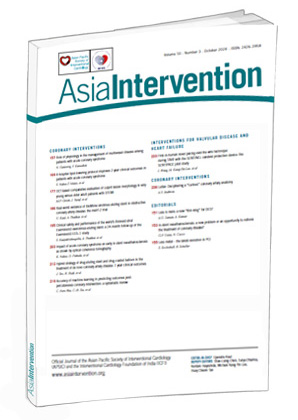The risk of recurrence of cardiovascular events remains high after acute coronary syndrome (ACS)1. Primary percutaneous coronary intervention (PCI) has been demonstrated to decrease mortality in patients with unstable coronary disease in acute settings2. However, long-term mortality after myocardial infarction has not improved in the same manner as short-term mortality3, and the reduction of the risk of long-term recurrent cardiovascular events in this setting probably represents the most important challenge in cardiology at present1234. While the introduction of drug-eluting stent (DES) technology for the treatment of significant culprit lesions due to coronary artery disease (CAD) was able to markedly reduce neointimal proliferation, at the same time, a high price was paid in terms of delayed and aberrant arterial healing, due to the effects of the antiproliferative drugs eluted by the stent that impaired physiological re-endothelialisation and vascular remodelling. Still, the incidences of target lesion revascularisation and recurrent stent thrombosis (ST) due to early and late ST in ACS patients remain remarkable5.
Stent technology evolved, but different profiles of clinical complications after stent implantation were observed. The first generation of DES were able to substantially reduce in-stent restenosis (ISR) events associated with bare metal stents (BMS) whilst increasing the incidence of in-stent thrombosis (IST). Stent restenosis was demonstrated to occur early in patients implanted with BMS, and the proliferation and migration of vascular smooth muscle cells were the prevalent mechanisms. Furthermore, newer-generation DES implants were associated with lower rates of IST than first-generation DES; however, a different type of complication known as “neoatherosclerosis” led to late stent failure. This distinct type of accelerated atherosclerosis of multifactorial aetiology develops inside of the stented segment of a coronary vessel. It is now emerging as a new problem that has yet to be solved, causing stent thrombosis and failure6.
Although coronary stenting resolves the problem of atherosclerotic lesion-induced myocardial ischaemia, it results in a new problem of neoatherosclerosis that represents the present challenge in the context of stent failure. Understanding the mechanisms underlying the pathophysiology of neoatherosclerosis is crucial to addressing this new challenge. In this issue of AsiaIntervention, Nakao and colleagues7, in a retrospective observational study conducted on 102 patients who had undergone percutaneous coronary intervention in both ACS and non-ACS settings, using optical coherence tomography (OCT) to investigate the presence of in-stent neoatherosclerosis, showed that neoatherosclerosis was more frequent in patients treated in an ACS setting. Optical coherence tomographic images identified a morphological abnormality and the characteristics of the tissue covering the stent struts, showing OCT to be a valid tool in this context7. However, the underlying causes of accelerated plaque formation after DES implantation are poorly elucidated, and there is still a substantial lack of knowledge regarding the underlying mechanisms. It occurs regardless of the stent type, and stent technology evolution is not achieving the desired results8. The advent of epigenetics may help us to understand the mechanisms underlying restenosis. Increasing evidence has demonstrated that epigenetics is involved in the occurrence and progression of in-stent restenosis and can provide new targets for stent failure drug development. However, epigenetic regulation takes time, especially if the drug targets the writer protein9.
Stettler et al demonstrated how this event is more dependent on focal triggers within the vessel involved in forming vulnerable lesions than the stent type. The finding that neoatherosclerosis is more prevalent in ACS populations compared to chronic coronary syndromes (CCS) confirms this concept and offers clinical proof that the target lesion failure is mainly related to lesion characteristics10. This observation highlights the marginal impact of stent evolution on the neoatherosclerotic process development, while plaque composition and stability have a significant effect. This means that the more unstable patients who are at higher risk remain those most exposed to recurrent events, still in the second-generation drug-eluting stent era, representing a warning for a profound reflection on the percutaneous treatment of coronaropathy. In light of recent observations regarding revascularisation in the context of ACS and CCS, it is necessary to begin to ask whether it is appropriate to pursue the path of technological evolution of the stent or to begin to embrace with more conviction new technologies inclined to consider cardiovascular intervention as the treatment of the artery in addition to the reopening of the stenosis and to jail the narrowing with foreign material to avoid recoil. The “leaving nothing behind” strategy is emerging as an alternative11. Still, the problems of recoil and embolisation need to be addressed, especially in complex scenarios and ACS, but the advent of new techniques, devices, and healthier local drugs will represent a change in the approach from opening the artery to healing the artery along with restoration of the flow.
Conflict of interest statement
The authors have no relationships relevant to the contents of this paper to disclose.
